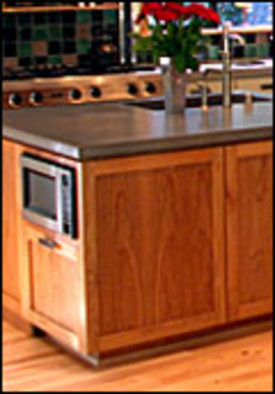 Concrete countertops bring elegance and custom styling to the kitchen with colors, profiles, and patterns to suit any design. |
Concrete Countertop Basics
A concrete countertop mix includes sand, stone, and cement along with proprietary ingredients that are unique to the manufacturer. Cement is mixed according to the desired outcome. “If the countertop has to cantilever out, for example, it has to be extra strong,” says Stephen Rosenblatt, president of Sonoma Cast Stone of Petaluma, Calif., which has 20 different formulas for their mixes.
Concrete tops are cast in thicknesses from 1½ inches to about 2 inches. Countertops that are too shallow can curl while curing, but concrete forms are often reinforced with rebar or wire mesh for strength and stability. Dyes penetrate the concrete completely for integral colors that won’t fade over time and sculptural properties allow for any edge profile.
Curing—a process that involves a chemical reaction between water and the cement—is regulated. A concrete surface must be kept moist as it cures so that crystals will grow and harden to create quality concrete. Moisture levels are maintained in various ways, including tenting the concrete to maintain consistent humidity levels. When completely cured—a process that can take up to 28 days—a penetrating sealer and wax are typically applied to this porous material.
Depending on thickness, countertops weigh 16 to 23 pounds per square foot. Many manufacturers won’t fabricate countertops over 10 feet in length because a longer top is difficult to muscle around the shop and install in a kitchen. Longer tops can be cast in place or cast in separate sections and installed.
Concrete Cautions
Concrete countertops have been around since the late 1970s but demand has grown as improved technology and skills have brought better results. Homeowners must be sure their contractors understand the principles of concrete, says Jeffrey Girard, P.E., president of Concrete Countertop Institute, Raleigh, N.C. Girard, a licensed professional civil engineer, started the institute and its contractor training programs to provide more information, guidance, and hands-on learning for concrete countertop fabricators. When interviewing contractors, ask for a product sample and perform your own tests to see how it stands up to heat, abrasion, cutting, and staining. Also, ask for customer references so you can view countertops that have seen use.
 |
||||||||||||
|
||||||||||||
A quick cleanup with mild detergent and water is recommended for regular cleanup. “It’s good to adopt a bartender mentality. Even if there are no drops on the counter, take a damp towel and wipe the counter occasionally,” says Marco Lucioni, owner of Lucioni Arts, in Seattle, Wash. Keep up on regular waxing, too. “Throw a little water on the counter. If it beads up, then it’s OK.” If not, then it’s probably time to wax again.
Concrete Options
Contemporary concrete is quite different from what it was six or seven years ago, says Sonoma’s Rosenblatt. “It’s a much more sophisticated art now, really beautiful, a totally different animal.” Technologies for sealing countertops are improving rapidly as is the rush to develop new products. Sonoma has created an innovative, stain-resistant concrete called NuCrete, the result of a proprietary process.
Another evolution is the addition of integral concrete sinks. While concrete countertops are able to accept undermount, farm-style, or drop-in sinks with ease and a bit of caulking, the molded-in-place sink is also an option.
Calculating Concrete Costs
Concrete mix is relatively inexpensive, but the process of handcrafting drives the price. Concrete countertops can range from $68 to $150 per square foot when all the bells and whistles—such as embedded items, special grinding, and profiles—are included. For NuCrete, add about 15 percent. Backsplashes are $15 to $25 per lineal foot.
Installation costs vary. While one shop may advise using a skilled granite contractor, another will suggest that installation only requires a few drops of adhesive and enough muscle to lift and set the countertop on the cabinets. Cabinets, by the way, do not typically need any extra support to handle these tops.
Installation does require a bit of precision shimming, though. Countertops with multiple sections require shifting, shimming, and leveling of adjoining slabs to get them properly butted and seamed. Finally, don’t underestimate the skill involved in not hurting yourself, not damaging the countertop or cabinets, and properly installing the sink.
Most countertops are handcrafted in custom forms created at the manufacturer’s facilities, where the preparation and curing can be better controlled. Those who want a countertop cast in place in the kitchen should be cautious. While it may seem like a valid method, it can be risky and messy. Concrete can be a difficult substance to work with, which is “why concrete countertops are so expensive. People are paying for the skill, craftsmanship, and labor,” Girard says.
Cleaning, Maintenance, and Repair
Concrete countertops vary so it’s important to talk to the manufacturer about how to use, care for, and repair your concrete countertop. Concrete will get hairline cracks, but they should not be visible if the product is well made. Concrete is brittle, not elastic, so tops can suffer chips from sharp points or impact. Contact the manufacturer for their repair kits or instructions for repair.
Concrete countertops are usually treated with a penetrating sealer, but sealers differ. Depending on the manufacturer, some tops may require annual resealing. Typical maintenance includes waxing monthly to three or four times a year, depending on use. Waxing a countertop is similar to waxing a car: apply wax, let dry, and buff out.
Hot pots or pans can damage the counter’s wax surface, but it can be rejuvenated by rubbing out the damaged area and re-waxing. Use cutting boards and coasters to avoid acidic substances that can etch and oils that can stain if left on the concrete surface. Be especially careful about cutting on your concrete countertop. Cutting will not only dull your knife but damage the seal on your counter. A damaged seal allows liquids to penetrate and stain the concrete.
Credit: Renovate Your World




























